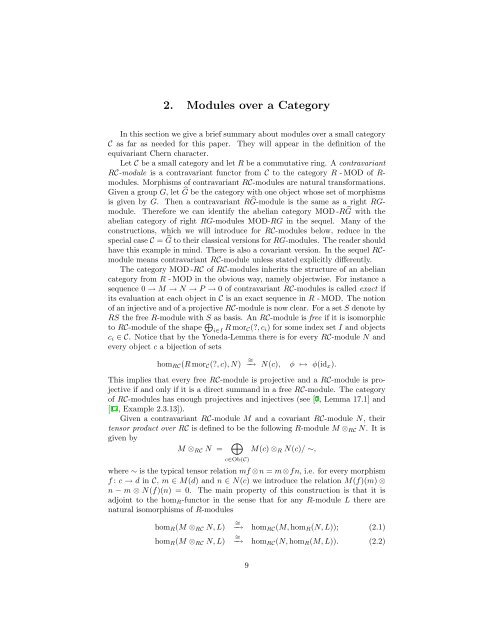Equivariant Cohomological Chern Characters
Equivariant Cohomological Chern Characters
Equivariant Cohomological Chern Characters
You also want an ePaper? Increase the reach of your titles
YUMPU automatically turns print PDFs into web optimized ePapers that Google loves.
2. Modules over a CategoryIn this section we give a brief summary about modules over a small categoryC as far as needed for this paper. They will appear in the definition of theequivariant <strong>Chern</strong> character.Let C be a small category and let R be a commutative ring. A contravariantRC-module is a contravariant functor from C to the category R - MOD of R-modules. Morphisms of contravariant RC-modules are natural transformations.Given a group G, let Ĝ be the category with one object whose set of morphismsis given by G. Then a contravariant RĜ-module is the same as a right RGmodule.Therefore we can identify the abelian category MOD -RĜ with theabelian category of right RG-modules MOD-RG in the sequel. Many of theconstructions, which we will introduce for RC-modules below, reduce in thespecial case C = Ĝ to their classical versions for RG-modules. The reader shouldhave this example in mind. There is also a covariant version. In the sequel RCmodulemeans contravariant RC-module unless stated explicitly differently.The category MOD -RC of RC-modules inherits the structure of an abeliancategory from R - MOD in the obvious way, namely objectwise. For instance asequence 0 → M → N → P → 0 of contravariant RC-modules is called exact ifits evaluation at each object in C is an exact sequence in R - MOD. The notionof an injective and of a projective RC-module is now clear. For a set S denote byRS the free R-module with S as basis. An RC-module is free if it is isomorphicto RC-module of the shape ⊕ i∈I R mor C(?, c i ) for some index set I and objectsc i ∈ C. Notice that by the Yoneda-Lemma there is for every RC-module N andevery object c a bijection of setshom RC (R mor C (?, c), N)∼ =−→ N(c), φ ↦→ φ(id x ).This implies that every free RC-module is projective and a RC-module is projectiveif and only if it is a direct summand in a free RC-module. The categoryof RC-modules has enough projectives and injectives (see [7, Lemma 17.1] and[17, Example 2.3.13]).Given a contravariant RC-module M and a covariant RC-module N, theirtensor product over RC is defined to be the following R-module M ⊗ RC N. It isgiven byM ⊗ RC N =⊕M(c) ⊗ R N(c)/ ∼,c∈Ob(C)where ∼ is the typical tensor relation mf ⊗n = m⊗fn, i.e. for every morphismf : c → d in C, m ∈ M(d) and n ∈ N(c) we introduce the relation M(f)(m) ⊗n − m ⊗ N(f)(n) = 0. The main property of this construction is that it isadjoint to the hom R -functor in the sense that for any R-module L there arenatural isomorphisms of R-moduleshom R (M ⊗ RC N, L)hom R (M ⊗ RC N, L)∼ =−→ hom RC (M, hom R (N, L)); (2.1)∼ =−→ hom RC (N, hom R (M, L)). (2.2)9
















